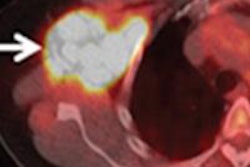The hybrid modality matched PET/CT for sensitivity in this clinical application, and FDG-avid focal bone lesions had greater conspicuity on PET/MRI. The researchers attributed the latter result to longer tracer-to-image time for PET/MRI, which allowed for more tracer accumulation by FDG-avid focal bone lesions and more tracer washout from background bone.
"This study contributes to the emerging evidence supporting PET/MRI as an alternative to PET/CT for the initial staging and subsequent restaging of various malignancies," lead author Dr. Tyler Fraum, a resident at the university's Mallinckrodt Institute of Radiology, told AuntMinnie.com.
Fraum and colleagues analyzed 190 general oncology patients, who received whole-body PET/CT and whole-body PET/MRI with equal amounts of FDG. Thirteen patients were found to have a total of 50 focal bone lesions.
On average, the ratio of the mean standardized uptake value (SUV) for FDG-avid focal bone lesions to the mean SUV for background bone was greater for PET/MRI. In addition, 80% of lesions were visually ruled as having equal or greater conspicuity on PET images taken from PET/MRI scans.
"Our findings suggest comparable sensitivity of PET/MRI and PET/CT for FDG-avid osseous lesions," Fraum said. "The potential benefits to patients include less radiation exposure and possibly also fewer total diagnostic studies, [compared with] patients needing both MRI and PET/CT for complete cancer staging."
While other studies have found that PET/MRI provides better anatomic delineation of osseous metastatic disease than PET/CT, this study concludes that PET/MRI is more likely to provide an anatomic correlate for an FDG-avid bone lesion than PET/CT.
"The identification of an anatomic correlate has implications for whether a lesion seen on PET is favored to represent malignancy versus an infectious or inflammatory process," Fraum said. "The presence of such anatomic correlates is especially important for lesions that are only mildly hypermetabolic on PET."



















